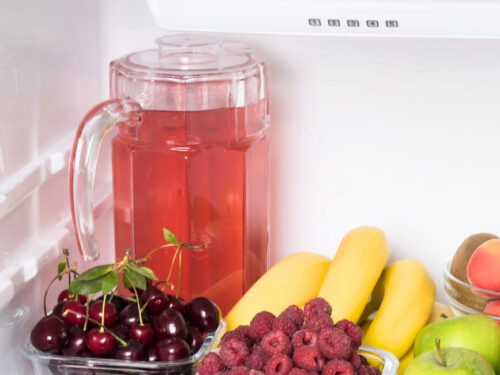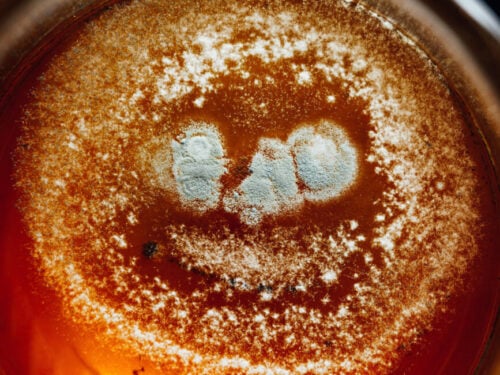Ever open your fridge to discover a forgotten pitcher of iced tea in the back? You’re not alone!
As tea lovers, many of us find ourselves making way more tea than we can sip in a single session, especially when brewing large batches to beat the heat. When it comes to storing tea, whether it’s a delicate white tea or a robust black tea, knowing the best way to keep it fresh can be a bit of a puzzle.
But we’re here to help you out! Let’s talk tea, and the best ways to enjoy it in its prime.

How Long Does Tea Last in the Fridge?
Here’s the short answer to quench your curiosity: Generally, tea can stay fresh in the fridge for about 3 to 5 days. If you’ve used an airtight container and kept your brew away from strong-smelling foods, you might even be able to stretch that to a full week before the taste is altered. This can obviously vary based on the type of tea and how it was prepared and stored. (A sweet tea with sugar, for example, will keep differently than a simple cold brew tea.) Storing your tea in the fridge is a good idea if you want to extend its shelf life, especially during those warmer months.
Now, if you’re eyeing that pitcher of iced tea in your fridge and wondering if it’s still good to drink, consider when you made it and how it’s been stored. If it’s within that golden window of a few days and smells as fresh as the day you brewed it, you’re probably good to go. But if you’re pushing past that week mark or notice anything off in flavor or appearance, it’s best to brew a new batch. After all, fresh tea is always the best tea.

Factors That Affect Tea’s Shelf Life in the Fridge
The Type of Tea: Black tea. White tea. Oolong tea. Green tea. Herbal tea. Not all teas are created equal, and the shelf life of your tea can vary depending on what you’re sipping. It really comes down to each tea’s processing methods and ingredients. For instance, teas with a higher moisture content (usually less processed teas like green tea or certain herbal teas) might be more susceptible to mold and bacteria growth. In contrast, thanks to its full oxidation process, black tea may offer a slightly longer shelf life.
The Way It’s Prepared: How you brew your tea plays a crucial role in determining its shelf life. Cold brew tea, made by steeping tea leaves in cold water for an extended period of time, is less prone to bacteria growth due to the absence of heat. On the other hand, Sun tea, brewed by placing tea in direct sunlight, can be a bit risky due to the gradual increase in temperature. This can make for a perfect breeding ground for bacteria if not immediately refrigerated. Hot-brewed tea that’s cooled down to room temperature before refrigerating needs careful handling to avoid bacterial growth during the cooling process.
How It’s Stored: The mantra for extending your tea’s fridge life? Say it with me: 🧘♀️ Airtight containers. Away from direct sunlight. Stored in a cool, dry place.🧘♀️ Oxygen, light, and heat are the archenemies of flavor and freshness. By sealing your tea in an airtight container, you protect it from the oxygen that can hasten oxidation and spoilage, and also from absorbing the odors in your fridge. (Ew is right. Who wants that?) Keeping it away from light and heat helps to preserve the delicate flavor of your tea.
What You Add To It: Enjoy your tea with a bit of milk, fruit juice, or sweetener? While delicious, these additions can greatly affect how long your tea remains fresh in the fridge. Milk and fruit juices can introduce bacteria or accelerate spoilage due to their own perishable nature. Sweeteners can also alter storage dynamics by making tea more appealing to bacteria. Plain tea tends to have a longer fridge life, so consider adding these just before you’re ready to drink your tea, rather than before you store it.

Tips for Storing Tea in the Fridge
Cool It Quickly: One of the golden rules for preserving the quality of tea, especially when dealing with hot-brewed tea, is to cool it down as quickly as possible. Not only to preserve the delicate flavor of the tea, but as a food safety tip. By rapidly reducing the temperature of your freshly brewed tea, you significantly minimize the window of opportunity that bacteria has to growth. This is especially important for tea types that are more susceptible to spoilage. Once it reaches room temperature, don’t let it lounge on your counter. Get it into the fridge asap to lock in freshness and keep those health benefits intact.
Use Airtight Containers: To maintain tea’s best taste, reach for mason jars or tea tins. These containers offer an airtight seal that prevents tea from absorbing the flavors and odors of its fridge food cohabitants. Your fridge will further shield the tea from direct light and heat sources, which will keep your tea fresher for longer.
Label It: Keeping track of how long your tea has been stored can be difficult sometimes. Avoid the mystery altogether and get into the habit of labeling your containers with the date it was made. Without any looming concerns, you can just enjoy your tea at its peak freshness.

Signs of Spoilage
Knowing when to say goodbye to your tea is crucial for ensuring food safety and freshness. So, how can you tell if your tea is past its prime? Here are some clear indications:
- Off-Smell: If your tea smells sour, musty, or just not right, that’s a red flag. Fresh tea should have a pleasant aroma, true to its type, whether that’s the delicate scent of white tea or the robust fragrance of black tea.
- Cloudiness: While some teas may become slightly cloudy when cooled, a noticeable murkiness or sediment at the bottom of your container can indicate spoilage, especially if it wasn’t there when you first stored it.
- Presence of Mold: This is the most definitive sign of spoiled tea. If you see mold growing in the container, discard the tea immediately! Mold should never be taken lightly.
When in doubt, err on the side of caution. It’s better to brew a new batch of tea than risk the health implications that come with consuming expired tea.

Tips for Tea Lovers
As your tea nears the end of its shelf life, here are some creative ways to ensure it doesn’t go to waste:
- Throw a Tea Party: If you have tea that’s still good but nearing its expiration date, why not host a tea party? Serve it as iced tea or hot tea, depending on the season, and share the joy of tea with friends.
- Delicious Teas Infused with Fruit Juice: For a refreshing twist, mix your nearly-expired tea with fruit juice to create a new beverage. Plus, it’s a great way to stay hydrated on a hot summer day.

Check Out These Tea Related Posts
Conclusion
Now that we’ve covered the different shelf lives of various tea types and proper storage techniques, you can go on and brew in style!
What’s your favorite tea? Do you enjoy hot brew over cold? What do you add to your teas? We want to know! Spill the tea in our comment section!
By keeping these tips in mind, you’re not just preserving tea. You’re preserving a moment of joy, a taste of comfort, and a sip of satisfaction. So go forth and brew, my friends.
Happy sipping!






0 Comments